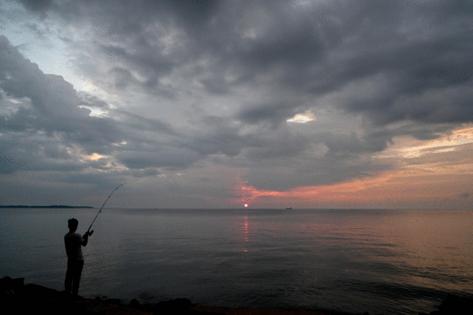Dan Rodricks: A Chesapeake fishing captain's long love affair with the bay
Published in Outdoors
BALTIMORE — Somewhere in the vast Chesapeake Bay, there’s a fishing spot known as Ed’s Lump. It is believed to be the remnants of a giant oyster reef, rising from deep water to within 24 feet of the surface. It’s where Ed Darwin, longtime charter boat captain and one of the bay’s greatest lovers, believed his customers would catch fish.
He was usually right.
Ed’s Lump is not marked on charts. Like a lot of fishy spots in the bay, its secret coordinates were lodged in Darwin’s noggin. He knew how to get to such places the old-school way, with dead reckoning, even in fog.
Darwin, who died Sunday, Sept. 22 at age 93, was widely known in Chesapeake fishing circles. He had an engineer’s mind and applied a kind of mystical science to the sport. He knew where and when to go, how to work the tides and currents, when to follow the gulls and pelicans, how to detect and remember the lumps and drop-offs in the bay where fish would forage.
“To be a guide,” he wrote in his unpublished memoir, “you must be able to think like a fish.”
Darwin worshiped at the altar of the Chesapeake Bay bridges; he almost always found fish for his customers around their many concrete pilings. He was a master at positioning his boat, the Becky-D, in a way to give anglers the best shot at hooking up.
“The number of fish you catch is directly proportional to your ability to anchor your boat,” Darwin told John Page Williams for a story in Anglers Journal a few years ago. “Fish will feed and lie in wait next to obstructions. Most of the time, in order to catch these fish, the boat must be placed where the fish can see and eat the offering. One foot either side is not acceptable.”
Darwin studied technical drawings of the first bay bridge because he wanted to understand what the underwater structures looked like.
“He really knew the bridges,” says his son, Dr. Peter Darwin, who worked in his youth on his dad’s boat, the 39-foot Becky-D. “I think he probably at one time or another fished or drifted every [piling] from east to west on both bridges. He could tell me which ones have underwater hangs or obstructions. When you look at those bridge pilings, some of them would have cross members above the water and some would mirror that under the water. So there would be, 10 or 15 feet down, a beam that the fish would hold on. He knew that and he fished it.
“He would also fish a bunch of the bars and lumps between the bridge and Mill Creek.”
Mill Creek, near Annapolis, is where Darwin docked the Becky-D.
Ed Darwin grew up in northwest Baltimore and developed a lifelong love of fishing as a kid. He fished the Gwynns Falls and the three-acre pond at Druid Ridge Cemetery (until the swans chased him away). His interest in the bay developed when a neighbor, Boris Tampico, put Darwin to work netting bait for tackle shops. He started fishing the bay when he was a teenager.
When he came out of the Army in the 1950s, Darwin attended night school at the University of Maryland to earn his teaching certificate. Starting in 1957, he taught electronics and mechanical drawing at Southern High School in Baltimore. He met his wife, Becky Kekenes, there — she taught physical education — and they started a family. They had two children, Peter and his sister, Melissa.
Darwin first guided fishing parties on a used boat out of Mill Creek. He saved enough money to have the Becky-D built in Deltaville, Va. Starting in 1968, he took customers fishing on weekends during the school year and six days a week in summers. He retired from teaching after 30 years.
I fished with Captain Ed a couple of times in the 1990s. We used spinning rods and light tackle, and we released almost all of the fish we caught. Darwin preferred that style of fishing. He made and named his own jigs and lures. One of them, the Teacher Bait or Schoolteacher Bucktail, worked well at the bay bridges. Kenny Kolodziejski, who was a student of Darwin’s at Southern High, still makes them.
“One of the greatest men I ever knew,” Kolodziejski said the other night. “With all the things Ed taught me over the years, he was just a phenomenal man.”
In winters, Darwin made rods and lures. He also became an excellent wood carver, creating likenesses of waterfowl and the rockfish he chased in the bay.
Darwin’s longtime mate, Jim Stickney, took over the Becky-D in 2021. But, even in his sunset years, Darwin continued to fish, if sometimes only for perch from his pier in Mill Creek. He kept live bait in his refrigerator up until his final days, says his daughter.
One day last summer, while on his son’s boat, Ed’s well-seasoned instincts kicked in again.
“We were at the bay bridge,” Peter Darwin says. “We weren’t really catching anything, and he said, ‘You know, I caught them on this piling last week,’ and I was like, ‘Dad, unfortunately, you haven’t been out on the water for a year now.’ But he was insistent, of course, so I humored him. We went to this certain piling and caught all these huge rockfish. It was so ingrained in him, he knew where they would be.”
©2024 Baltimore Sun. Visit baltimoresun.com. Distributed by Tribune Content Agency, LLC.







Comments